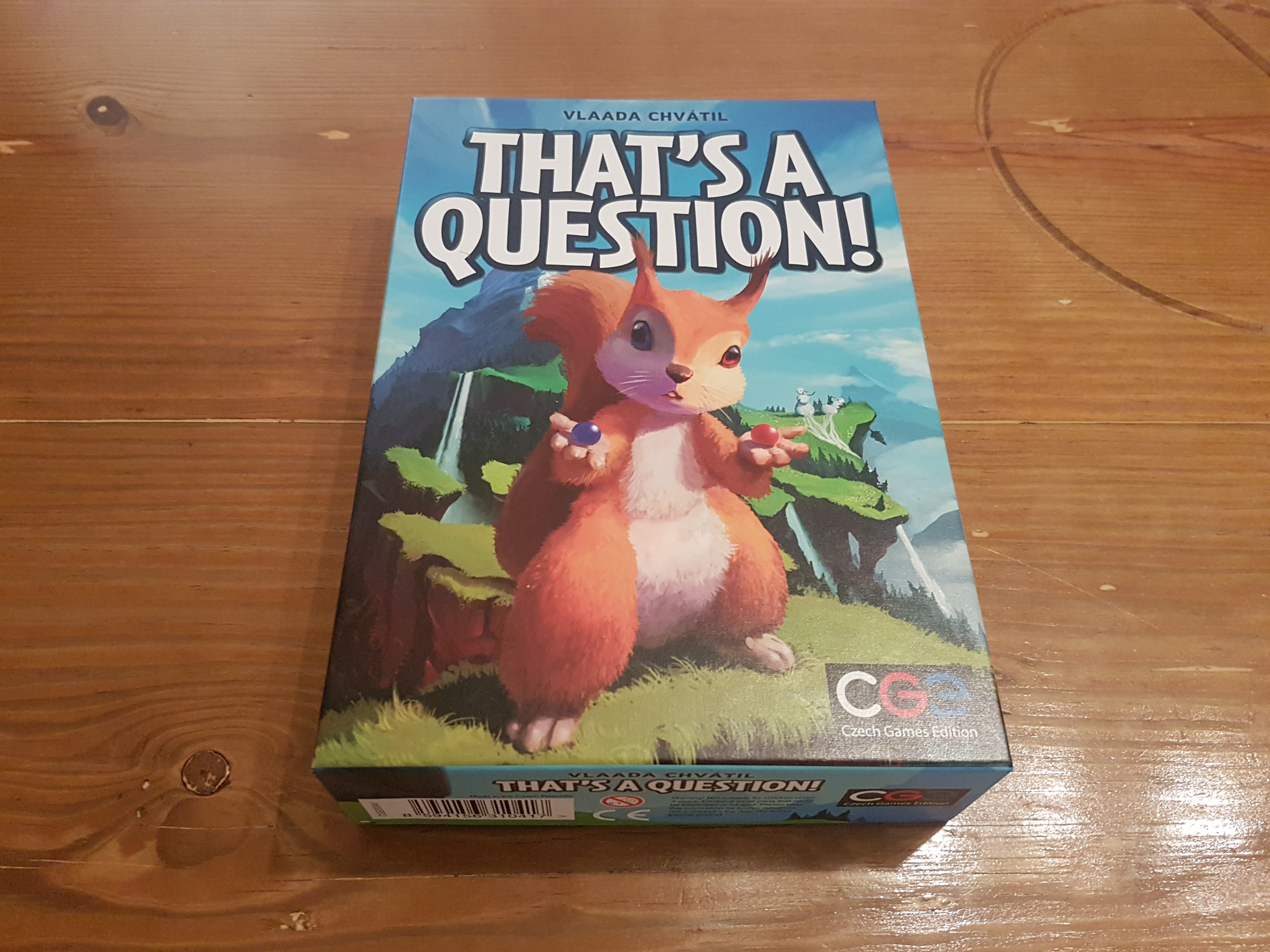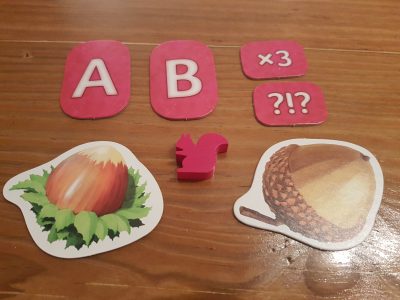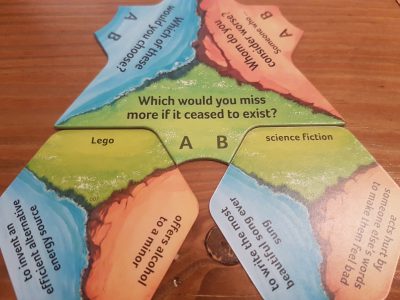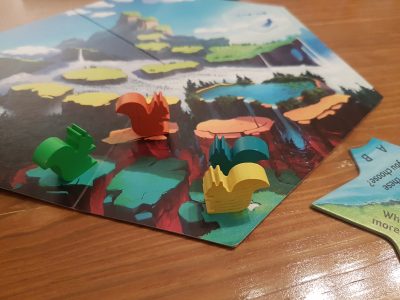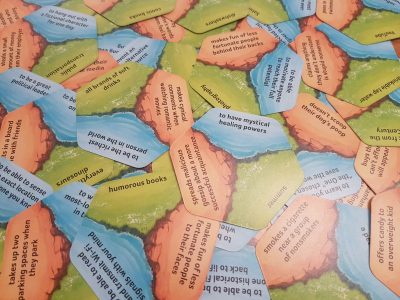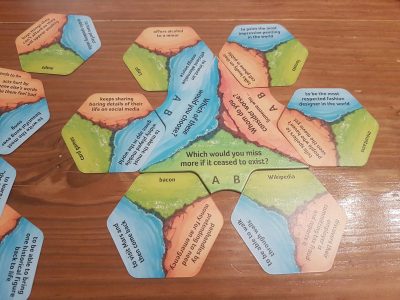That’s A Question! is the brand new party game from famed board game designer Vlaada Chvatil, published by Czech Games Edition. The game sees 3 – 6 players posing questions, voting on what a specific players answer will be and becoming climbing squirrels. Questions are split into three categories with answers being selected from hexagon shaped cards. However, does Vlaada have another huge hit on his hands? Let’s find out!
At the offset of the game, the side of the double-sided board is selected depending on the player count, the answer cards are shuffled and five are dealt to each player. The board indicates the amount of additional answer cards to stack on the board as a drawn pile, players choose a colour and take their respective squirrel meeple and tokens. For example, in a 5-player game 30 cards are used to form a draw pile and 25 are distributed to players for their starting hands: this means only 55 answer cards are used in a single 5 player game.
For 5/6 player games the rules are as follows. Each player, bar the starting player, gets an acorn/hazelnut token. The starting player will be the first to ask a question. Utilizing two of their 5 answer cards, matching to a category, the questioner asks any single player with an acorn the question. This gives a choice of A or B, via the two answer cards. The questioner then takes that players acorn so the same player can never be asked questions back to back.
The answerer, who can interpret the question and choices in any way they wish, must secretly and honestly answer A or B, by placing either token face down on the table. Anyone not involved in the question is a guesser. Guessers must decide whether they think the answerer will be voting A or B by also placing their A or B token face down. The rules state not to give away your guess, while others are voting, but it seems more natural to try to discuss. Especially as this evolves into trying to trick others to picking the wrong answer, adding some bluffing into the mix. Once voting is done the answer and guesses are revealed. Everyone that guessed correctly moves 1 space, for every incorrect answer the questioner moves 1 space and for being the answerer that player get to move 1 space.
Kickers are one-use tokens that adapt this scoring system. Each player has two of these tokens at the start of the game, to use whenever they like. The Times-Three kicker, as the name hints towards, scores the guesser 3 points instead of one if they are correct. The tough-question kicker enables that player to also, like the questioner, move 1 space for other players guessing incorrectly. Both follow the rules you cannot play both kickers at once and are discarded after use. When a player reaches the lake or meadow space on the score board they can reclaim one used kicker token, which one if both are spent is up to them.
Once a question is complete the used answer cards are discarded and the current questioner draws back up to 5 cards. Then the questioner role moves clockwise around table and the process starts again. The final round, rounds including each player asking a question, is triggered when the final 2 answer cards are drawn from the deck. Everyone will get to ask one final question and everyone gets one kicker back. At the end of the game whomever is furthest up the mountain wins.
The question sets are split into three categories, with the answer cards having one answer for each category. These are: “Which would you miss more if it ceased to exist?”, “Which of these would you choose?” and “Whom do you consider worse? Someone who…”. These are colour coordinated for ease of play: being green, blue and orange respectively. The cease to exist category has a mixture of things people would either love to cease or hate to lose, god forbid someone chooses Google! As the questioner you will have to combo answers together to make it an interesting decision and hard to guess for the other players.
The which would you choose category is similar to the age-old question of “what superpower would you want to have?”. There are some great abilities out there and the explanation behind the choices is somewhat enlightening at times, at least into that person’s mind. Finally, the whom is worst category is a bit of a mixed bag with things players may find a little irritating. An example of this is someone who… “doesn’t cover their mouth when coughing”. Compared to the other two categories’ answer options it’s a bit on the lame side.
The rulebook is an entertaining read much like with Galaxy Trucker. There has been a layer of thought put into making it fun to read rather than just stating the rules. A range of rule tweaks are included for games with 3 or 4 players, with adjustments such as doubling the number of kickers. As even the rules suggest the game works best with 5 or 6 players and these tweaks just allow the game to better function at a lower player count.
That’s A Question is extremely easy to explain, more so than most party games. Aiding this ease of play is the use of colour. The three colours for the three question types makes matching the answers incredibly intuitive. Intuitive to the extent, I have put the components of the game on the table and without any explanation players completely new to the game picked up and matched some answers out of interest of how it all works.
In part this simplicity and intuitiveness helps That’s A Question! get to the table, with friends and family members alike able to dive in. This same simplicity is a constraint on the game. This is definitely a party game and unlike Codenames I find it cannot double up as a filler between meatier games. It doesn’t seem to hold gamers’ attentions, especially when they are there to play games. This is compounded by the need to be in the right mood to fully get enjoyment out of the game.
Player interaction is high making this a very social orientated game. Players may constantly discuss answers before they are made and more entertainingly after, when an odd choice has seemingly been made. As a result, That’s A Question! becomes a conversation starter more than a game night game. Having something on the shelf that can do this is great for variety, though not everyone will want this slightly extrovert style game in their library. It is great for with people you think you know really well like family or close friends and as an icebreaker, get to know people and share a laugh, game with new friends or work colleagues.
Don’t go into That’s A Question! worrying about being embarrassing or overly prying questions. The topics have been carefully chosen to walk down a safe line, causing a lot of conservative answers. Far flung from the outrageous topics of Cards Against Humanity, this is almost too far in the opposite direction. If players go into the game for a laugh they can get plenty out, otherwise some gamers will be left thinking the topics are a tad plain. On top of this, the questions will have a limited lifespan when the same answers start to get paired together, as with many party games this would be the time to move on. I do believe That’s A Question! has a perfect time and place to be brought out I just haven’t found it yet.
Mechanically, the game works with only 3 players. I would not suggest playing with this lower player count as more players are needed to make the voting stage more interesting. It’s the buzz that you feel when you vote against the crowd but may still be right. By extension, there’s nothing better than when everyone votes one way, singing their certainties, only for the answerer to reveal the opposite. It gets the game and the conversation going and this situation is only heighted when the player count is closer to max.
There are a lot of answer cards in the box, a total of 108 are included. This is a necessity for keeping things fresh and it’ll be a couple of games before they’ve all even left the box. However, even after each has been used once there are still two other sides to be used and that’s before the mammoth amount of combinations are thrown into the mix. I feel some are added in to pad out the deck which is a shame. When drawing these lacklustre options, such as “Mountains” for ceasing to exist, players instantly discard the notion of using them, so it’s almost a waste including them in the box.
The components include a board made of thick cardboard and well-designed squirrel meeples which builds the game up to having a strong production value. This then tumbles down when the cards, a heavily used component, are thin card at best. They just fail to live up to that high quality portrayed by the rest of the components. As these are going to be shuffled and used constantly a slightly higher quality would have been perfect. Going one step further and making them double-sided would have helped the game excel.
Other than the squirrel meeples or the offering of a red and blue pill on the box art, a great nod towards The Matrix, the artwork and general components leave me uninspired. Going for the three question types and the use of shapes works well but it isn’t anything overly special. The question that really jumps to mind is, why squirrels and mountains? Now, That’s A Question! Thematically, it would be more “accurate” for the squirrels to be climbing to the top of a tree towards a golden acorn, than jumping from platform to platform up a mountain. There was always bound to be a disjointed feeling from the mechanics to the theme, but even alone the theme seems muddled.
How good this game is, to some extent, is left up to players. If everyone gets into the merriment or creates answer dilemmas then the game will shine and in-jokes can be formed. Often a great measure of a game’s impact can be if it is spoken about afterwards and That’s A Question! has created some entertaining post-discussions. The biggest issue is whole group needs to be in the right mood to play. If one isn’t quite feeling it then perhaps the rest laughing can drag them into enjoying it. Past this and without committing to the questions, voting etc. the game can fall a bit flat. I cannot say the Vlaada Chvatil has done it again and reached the heights of Codenames, but with the right group That’s A Question! can be an entertaining icebreaker.
[Editor’ Note: That’s A Question! Was provided to us by CGE for the review.]

